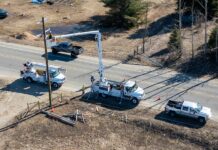This article is second in a series on how electricity is generated. The first, in January, was about clean-coal technology. Watch future issues for stories about renewables and other fuel sources.
There’s new excitement about nuclear power in the energy business, due to the advent of small modular reactors (SMRs).
This evolution has been spurred by the U.S. Department of Energy (DOE), which has awarded a dollar-for-dollar match to the Generation mPower LLC consortium to deploy up to five 180-megawatt (MW) SMRs at the Tennessee Valley Authority’s (TVA) abandoned Clinch River Breeder Reactor site in Oak Ridge, Tenn. The consortium of utilities and industry contractors includes TVA and 13 generation and transmission (G&T) cooperatives. Wolverine Power Cooperative, Michigan’s only G&T electric cooperative, is a participant.
Generation mPower LLC says its SMRs, housed in an underground containment structure, will include significant safety features built into the design, such as the ability to shut down “passively” (with help from gravity) if a malfunction occurs. The advanced integral pressurized water reactors can also be air-cooled (big reactors require millions of gallons of water daily) and the plants will be able to store high-level nuclear waste on-site for their 60-year expected life.
The SMR units, generally smaller than a rail car, cost much less than a full-size commercial nuclear power plant: $750 million compared to $5 billion to $10 billion for a 1,110-MW to 1,700-MW facility constructed from the ground up. Industry leaders are particularly enamored with the technology’s modularity—pre-fabricated units can be added as needed, avoiding the risk associated with locking up billions of dollars in a generating station during uncertain economic times.
“The mPower reactor will reduce risks connected with deploying nuclear power and become a flexible, cost-effective solution to meet U.S. energy needs while lowering greenhouse gas emissions,” Babcock & Wilcox, a nuclear equipment developer and manufacturer, touts on babcock.com. “Each mPower reactor that is brought on-line will contribute to the reduction of about 57 million metric tons of carbon dioxide emissions over the life of the reactor.”
Commercial operation of the consortium’s SMRs could begin as early as 2020, and the reactors—at 83 ft. tall and 13 ft. in diameter—will be about one-third the size of traditional nuclear plants.
“With the ability to add more modules, you can adjust your energy output to closely match your demand needs,” says Art Thayer, energy efficiency programs director for the Michigan Electric Cooperative Association. “If proven successful by the Tennessee project, this power source could lead to improvements in energy production and efficiency, air quality, energy security, international competitiveness, quality of life, and a reduction of carbon emissions and other pollutants.”
Nuclear power accounts for about 19 percent of the nation’s electricity supply, according to the U.S. Energy Information Administration (EIA), and about 10 percent of the electricity produced by G&Ts. And currently, eight G&Ts have minority shares in 12 different nuclear units owned and operated by large investor-owned utilities. One co-op G&T maintains a majority interest: Raleigh-based North Carolina Electric Membership Corporation owns 61.5 percent (694 megawatts) of a nuclear station unit. Overall, co-op investment in nuclear energy totals 2,710 MW.
In Michigan, while Wolverine does not have nuclear power in its generating fleet, it’s an important part of the co-op’s overall portfolio, supplying 23 percent of its members’ needs in 2012. The nuclear power used by non-Wolverine co-ops averaged between 15 percent and 25 percent in 2012. Find percentages for each co-op’s mix of all fuels used to generate power annually in Country Lines (March and September issues). At countrylines.com, click on “My Co-op”/co-op name/March issue.
Besides Wolverine Power Cooperative and Babcock and Wilcox, Bechtel Corp. (engineering/construction), and FirstEnergy Corp. (parent of 10 investor-owned utilities in Maryland, New Jersey, Ohio, Pennsylvania and West Virginia), are also part of the Generation mPower consortium.
-Angela Perez





